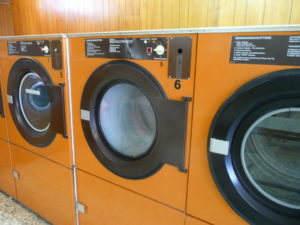Today, SevenPonds speaks with Philip Olson, an assistant professor of Science and Technology in Society at Virginia Tech. Olson researches bioethics and environmental ethics, analyzing society’s complex relationship with new technologies. He has a particular interest in the study of alkaline hydrolysis. Over the years, Olson has studied how receptive people are to this new technology.
Warning: This post contains detailed information about how remains are processed. Reader discretion is advised.

Credit: sts.vt.edu
Marissa Abruzzini: What made you want to study alkaline hydrolysis?
Philip Olson: My mom, actually! I was visiting my parents one summer, and my mom told my dad about this article she’d read on alkaline hydrolysis. She said it was about dissolving human bodies and flushing them down the drain. It wasn’t very flattering. I thought, “I gotta see that.” It sounded like something my department would be interested in. I wanted to know how people are responding to this. Do they accept it, or think it’s strange? How is this gonna go over?
I guess I should step back for a moment. The reason why my mom was telling my dad about this article is because my dad is actually a funeral director. He operates a 90-year-old family business in Minnesota. I had no intention of doing that kind of work myself, so it’s funny that I now study funeral technologies.
Marissa: I bet that gives you a different perspective on the industry, too.
Philip: I come at it from an interesting point of view. When I was growing up, the funeral business literally put food on the table.
Marissa: Can you describe the alkaline hydrolysis process? What does it involve exactly?
Philip: First, you have a chamber that’s shaped like a cylinder. It has this wire mesh tray that slides out. The body is placed on this tray, and then the operator slides it into the cylinder and seals the door. The body can’t have anything on except pure leather or silk. These materials will hydrolyze along with the body, but things like polyester won’t. So most funeral directors will wrap the body in a silk body wrap.

Credit: Wikimedia.org
Sodium hydroxide, or lye, is used to dissolve bodies in alkaline hydrolysis.
Marissa: What makes them hydrolyze?
Philip: It’s a mixture of water and alkali. The mixture is 95 percent water and 5 percent alkali (usually hydroxide or sodium hydroxide, AKA “lye”). That’s pumped into the cylinder and then heated.
Marissa: How long does it take to hydrolyze the body?
Philip: It depends on the amount of heat used, and the pressure. You need to get the fluid to heat beyond its boiling point for the process to work quickly. Most of the cylinders are pressurized to keep the water from fully boiling, and this speeds the hydrolysis process up. It only takes about two or three hours. But if the system isn’t pressurized, it can take as long as 12 hours.
One of the high-pressure system manufacturers actually makes submarines for the British Navy. It uses the same kind of high-pressure technology — some alkaline hydrolysis machines use actual submarine doors.
Marissa: Is the high-pressure system more expensive?
Philip: Oh yes. It costs about half a million dollars for the high-pressure machine, and about half that price for a low-pressure system.
Marissa: So what happens after the alkali and water is pumped into the cylinder?
Philip: The body becomes liquefied. It looks a little bit like motor oil. This liquid has a very high pH, so you have to add an acid like carbon dioxide to the remaining liquid in order to make it neutral. They also cool the liquid down so that it can be sent to waste water management.

Credit: Wikimedia.org
Liquids are neutralized and sent to waste water management facilities for processing.
Marissa: Is it toxic?
Philip: No, it’s not. Part of the controversy about alkaline hydrolysis is that this remaining liquid is processed by the same department that recycles drinking water. But the liquid is completely sterile and inert at this point. Everything is already broken down. There’s no DNA or RNA left because the heat and alkali has destroyed it.
Some experts claim that there aren’t any prions present either, and a few studies have backed this up. Prions are a problem in mad cow disease, and there is a human equivalent of that. Experts claim that the remaining liquid doesn’t have any prions, but I recently talked to a scientist at Virginia Tech who was skeptical. I’ll need to see more studies on that.
Marissa: What happens to the bones? They aren’t hydrolyzed, right?
Philip: Right, you still have bone matter left over after you drain the liquid. The bones are wet, so they need to be dried. These bones are actually more brittle than cremated remains. And as in cremation, you’re not really getting “ashes.” In cremation, you burn the body away, and what you’re left with is bone and bone fragment, which you then grind into a powder. Alkaline hydrolysis is a similar process, except you use liquid instead of flames, and you get 20 percent more remains, on average. So you’ll need a bigger urn.
Marissa: I know that with cremation, your loved one’s remains are often mixed a little bit with others who were cremated in the same spot. Does this happen in alkaline hydrolysis?
Philip: They call that “co-mingling,” yeah. There’s less co-mingling with alkaline hydrolysis. It’s inevitable that there will always be some.
Marissa: So you said that the bones need to be dried before they can go through the grinding process. How does that work?
Philip: How do you think it works? Take a guess!

Credit: Wikimedia.org
Marissa: You can’t just leave them out. That’d be inefficient…I have no idea.
Philip: Clothes dryer.
Marissa: No! Really?
Philip: Yes. They put bones on those shoe trays that you use to keep your sneakers from bouncing around, and they dry them in a regular clothes dryer. They don’t want to use it, but no one’s come up with a better solution yet. It’s fascinating to me, because so many people find this fact disturbing. There’s this boundary between industrial and domestic living spaces, and we try to keep those boundaries intact. And the idea that the same machine that dries your kids’ clothes is also drying bones creeps people out. Maybe it seems too casual? Or offensive to the body itself?
And that’s where people think of alkaline hydrolysis as controversial. We imagine we’re flushing our loved ones down the drain. In reality, nearly every funeral technology has one or two “creepy” aspects.
Please join us next week for Part Two of our interview with Philip Olson, where we talk about whether alkaline hydrolysis is environmentally-friendly.

 What Is Alkaline Hydrolysis?
What Is Alkaline Hydrolysis?


 First the Wealth Gap, Now the U.S. Has a Growing Health Gap
First the Wealth Gap, Now the U.S. Has a Growing Health Gap

 Our Annual Seven Holiday Gifts for Someone Who Is Grieving, 2024 Edition
Our Annual Seven Holiday Gifts for Someone Who Is Grieving, 2024 Edition














